This week's post will look at the last two physical attributes of the stamps of this series before I get into a detailed discussion of the papers themselves. The first of these is the gum types found on the stamps and the second is the chalk surfacing found on the higher value landscape stamps.
At first glance, the gum appears to simply be a uniform PVA gum. While it is true that the gum is indeed PVA, there are some subtle differences in the sheen of the gum found on some stamps that suggests that there were slight differences in chemical composition of the gum used. Furthermore, the gum used by BABN appears to be different from the gum used by CBN on their stamps. I will spend some time discussing these differences, all of which are considered by Unitrade to be too specialized to warrant mention in their catalogue.
The chalk surfacing is an aspect of the paper that Unitrade has begun to pay attention to in recent years. I will discuss and show the differences between the vertical ribbed surfacing, what Unitrade calls the horizontal ribbed surfacing, and the completely smooth surfacing of the later printings.
Gum Used on CBN and Ashton Potter/BABN Printings
The gum found on the CBN printings of the low value prime minister's sketches and the Ashton Potter/BABN printings of the $1 and $2 is very similar. The gum generally is quite thinly applied because the texture of the wire-side of the paper is not at all obscured by the gum. The gum itself is colourless and under magnification, some very minute cracking is visible.
Where the gum does differ between printings is in the sheen. Normally, on most of the earlier CBN printings, the gum has a universal satin sheen in that it reflects a fair amount of light that shines down on it. Later printings can be found with a gum that is more matte, reflecting less light than the normal gum. I call this the eggshell PVA, being that the sheen is more of an eggshell, rather than a satin sheen.
The picture below shows two stamps with the normal satin PVA gum:

So, if you look at the above picture, you can see that the gum does reflect a fair amount of light, and that the texture of the paper is visible through the gum.
The picture below shows an example of the eggshell PVA gum on a stamp that is printed on ribbed effect paper (I will discuss this in my next post):
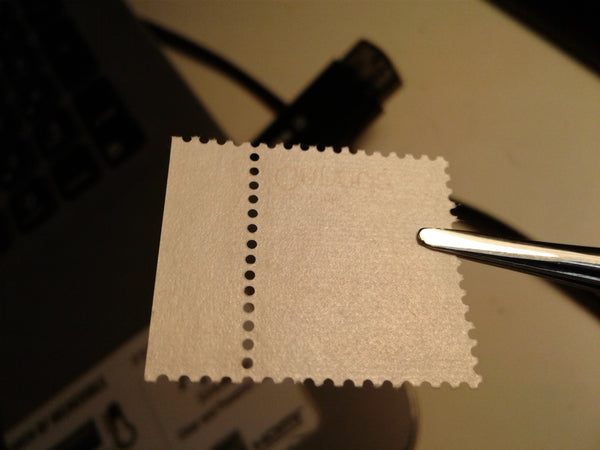
Here, you can see that this gum is quite matte and does not reflect much light at all. Also, the texture of the paper is readily visible in the gum.
In my examination of thousands of stamps, I have found that the matte PVA gum only seems to be found on later printings of the low values and the coil stamps. Given that the 8c coil does not appear until April 1974, it would appear that this gum is found on printings after March 1974. Most all of the CBN printings of the 7c and 8c values, issued in late 1976 and 1977 are generally all found with the matte gum. The $1 and $2 values are generally only found with the satin PVA gum.
Gum Used on BABN Printings
The gum found on the BABN printings is generally very uniform in appearance and smooth, appearing to be a bit thicker than the gum used on the CBN printings of similar stamps. Like the gum found on CBN printings of the low values, it is generally colourless. However on the mid-values and $1 stamps, it is a very light cream colour. I know this because used examples of these stamps appear much whiter on the back than gummed examples, which suggests that the gum itself is actually a light cream colour. Unlike the CBN gum, the BABN gum is smooth and does not show the texture of the underlying wire side of the paper. It also reflects a satin sheen when viewed at an angle to a light source.
The picture below shows a CBN printing of the 8c Queen Elizabeth II stamp next to a BABN printing:
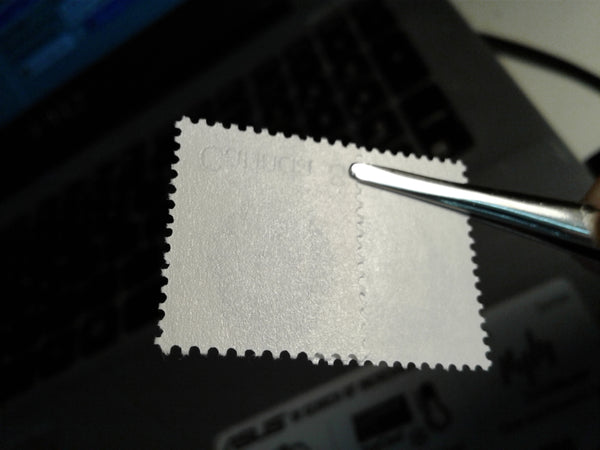
The BABN printing is shown on the right, while the CBN printing is shown on the left. As you can see, there is no significant difference in the sheen of the gum, except that the CBN printing is a little more matte. What is different is that the BABN printing has a much smoother appearance, while the CBN gum shows the texture of the wire side of the paper that it has been applied to.
In addition to the smooth gum, some of the very last printings of the BABN booklet stamps made in 1977 and 1978 are found with gum that shows distinct vertical ribbing on its surface. I have not seen used examples without gum that show the ribbing in the paper, which leads me to conclude that it is a feature of the gum, rather than the paper. It has listed in Unitrade on some stamps of the 1977-1982 Floral Issue, but it is not listed on this issue. The picture below shows the difference between the smooth an ribbed gums:
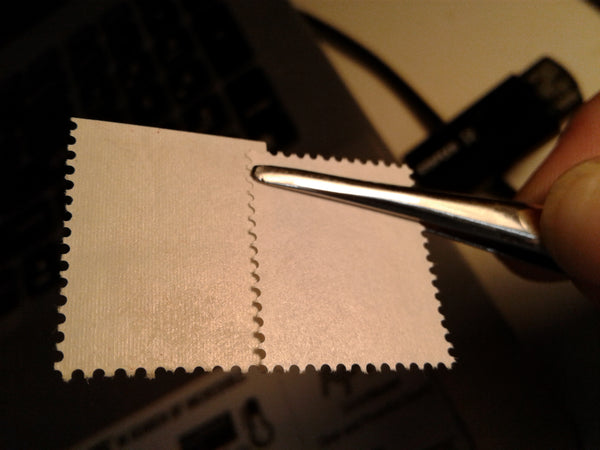
The stamp on the left is a booklet single of the 10c Queen with the ribbed gum, and on the right, a sheet stamp of the 10c, with the normal, smooth gum.
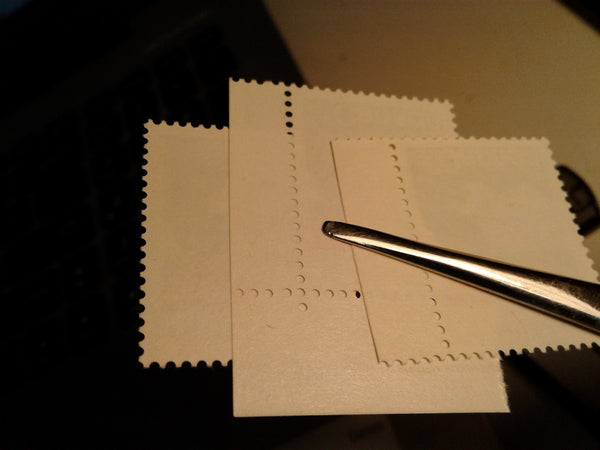
This picture shows several printings of the 10c forests stamp, each with the light cream PVA gum. There is one printing of the 10c I have found that has colourless gum, as it appears the normal white paper colour on the back. I have not found this on any of the other values in the set.
Chalk Surfacing on Mid and High Value BABN Printings
The initial printings made of these stamps in 1972 were made using a chalk coating that left a ribbed appearance on the paper the coating was applied to. I know that it was not used after 1972 because it is only found on the 1972 commemoratives printed by BABN and not those issued in 1973. The ribbing can be seen as distinct vertical striations down the stamps, and these are most easily seen then the stamps are held at an angle to a strong light source. The high resolution scan below shows an example of the vertical ribbed coating on the 10c forests:

Here if you look closely, you should be able to see the vertical striations in the paper in the top selvage around the word "British" and at the top of the stamp near the postes/postage inscription.
Later, starting in 1973, this coating was replaced by a smoother coating. Initially this coating shows very, very fine horizontal striations that are much less distinct that run across the surface of the stamp and are barely visible in reflected light. Then in 1974 onward, the coating was made completely smooth and even. The scan below shows an example of the smooth coating on the same basic stamp:
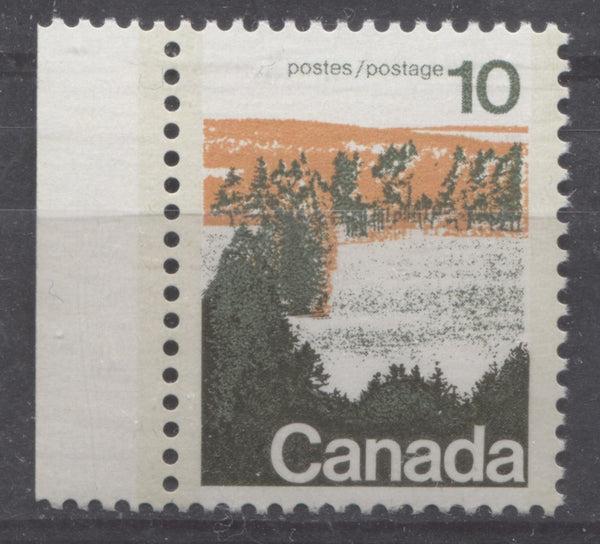
Compare this image to the one above, and you should be able to see that the surfacing on this paper is completely smooth, while the other one is clearly ribbed.
The picture below shows both types in reflected light:

The ribbed coating is shown at the top of the picture, and is very clear, while the smooth paper coating is shown on the stamp underneath it.
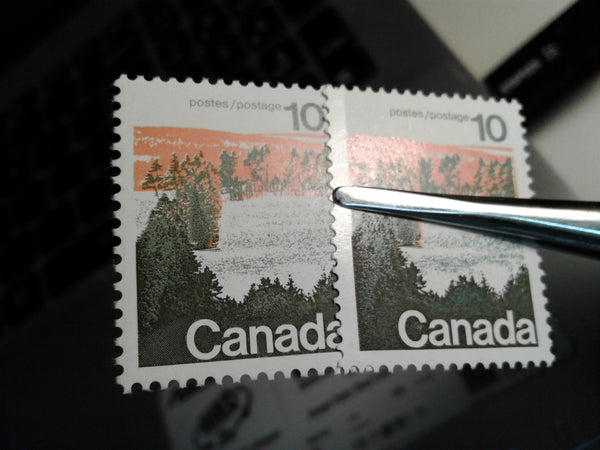
This picture shows a stamp with the horizontal ribbed coating on the left, and the even, completely smooth coating on the right. The difference is too subtle to show up clearly in a picture like this, but basically the stamp on the right shows no striations across the design in either direction. In contrast, the stamp on the left shows very, very light horizontal striations across the design.
As you will see as you get into working with the stamps of this issue, the stamps with the vertical ribbed coating tend to be relatively common, at least with the OP-4 tagging or OP-2 3 mm tagging on dull fluorescent paper. However, the printings made on the smooth paper with the light horizontal ribbing are always scarce and worth a premium, as they were only made for a very short time before being replaced by the type 2 printings.
This concludes my examination of these two attributes and next week I will be ready to begin my discussion of the papers used for these stamps. Next week I will be focusing on the physical attributes of paper texture, thickness, and weave direction. Later, I will examine, in detail, the fluorescence levels of the papers. After that I can begin looking at specific values in detail.

